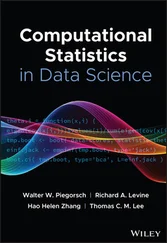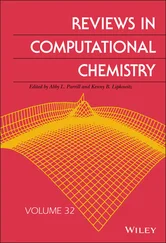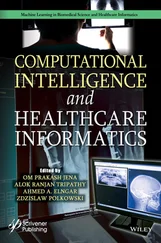Computation in BioInformatics
Здесь есть возможность читать онлайн «Computation in BioInformatics» — ознакомительный отрывок электронной книги совершенно бесплатно, а после прочтения отрывка купить полную версию. В некоторых случаях можно слушать аудио, скачать через торрент в формате fb2 и присутствует краткое содержание. Жанр: unrecognised, на английском языке. Описание произведения, (предисловие) а так же отзывы посетителей доступны на портале библиотеки ЛибКат.
- Название:Computation in BioInformatics
- Автор:
- Жанр:
- Год:неизвестен
- ISBN:нет данных
- Рейтинг книги:4 / 5. Голосов: 1
-
Избранное:Добавить в избранное
- Отзывы:
-
Ваша оценка:
- 80
- 1
- 2
- 3
- 4
- 5
Computation in BioInformatics: краткое содержание, описание и аннотация
Предлагаем к чтению аннотацию, описание, краткое содержание или предисловие (зависит от того, что написал сам автор книги «Computation in BioInformatics»). Если вы не нашли необходимую информацию о книге — напишите в комментариях, мы постараемся отыскать её.
Computation in BioInformatics — читать онлайн ознакомительный отрывок
Ниже представлен текст книги, разбитый по страницам. Система сохранения места последней прочитанной страницы, позволяет с удобством читать онлайн бесплатно книгу «Computation in BioInformatics», без необходимости каждый раз заново искать на чём Вы остановились. Поставьте закладку, и сможете в любой момент перейти на страницу, на которой закончили чтение.
Интервал:
Закладка:
Table of Contents
1 Cover
2 Title Page
3 Copyright
4 Preface
5 1 Bioinfomatics as a Tool in Drug Designing 1.1 Introduction 1.2 Steps Involved in Drug Designing 1.3 Various Softwares Used in the Steps of Drug Designing 1.4 Applications 1.5 Conclusion References
6 2 New Strategies in Drug Discovery 2.1 Introduction 2.2 Road Toward Advancement 2.3 Methodology 2.4 Role of OMICS Technology 2.5 High-Throughput Screening and Its Tools 2.6 Chemoinformatic 2.7 Concluding Remarks and Future Prospects References
7 3 Role of Bioinformatics in Early Drug Discovery: An Overview and Perspective 3.1 Introduction 3.2 Bioinformatics and Drug Discovery 3.3 Bioinformatics Tools in Early Drug Discovery 3.4 Future Directions With Bioinformatics Tool 3.5 Conclusion Acknowledgements References
8 4 Role of Data Mining in Bioinformatics 4.1 Introduction 4.2 Data Mining Methods/Techniques 4.3 DNA Data Analysis 4.4 RNA Data Analysis 4.5 Protein Data Analysis 4.6 Biomedical Data Analysis 4.7 Conclusion and Future Prospects References
9 5 In Silico Protein Design and Virtual Screening 5.1 Introduction 5.2 Virtual Screening Process 5.3 Machine Learning and Scoring Functions 5.4 Conclusion and Future Prospects References
10 6 New Bioinformatics Platform-Based Approach for Drug Design 6.1 Introduction 6.2 Platform-Based Approach and Regulatory Perspective 6.3 Bioinformatics Tools and Computer-Aided Drug Design 6.4 Target Identification 6.5 Target Validation 6.6 Lead Identification and Optimization 6.7 High-Throughput Methods (HTM) 6.8 Conclusion and Future Prospects References
11 7 Bioinformatics and Its Application Areas 7.1 Introduction 7.2 Review of Bioinformatics 7.3 Bioinformatics Applications in Different Areas 7.4 Conclusion References
12 8 DNA Microarray Analysis: From Affymetrix CEL Files to Comparative Gene Expression 8.1 Introduction 8.2 Data Processing 8.3 Normalization of Microarray Data Using the RMA Method 8.4 Statistical Analysis for Differential Gene Expression 8.5 Conclusion References
13 9 Machine Learning in Bioinformatics 9.1 Introduction and Background 9.2 Machine Learning Applications in Bioinformatics 9.3 Machine Learning Approaches 9.4 Conclusion and Closing Remarks References
14 10 DNA-RNA Barcoding and Gene Sequencing 10.1 Introduction 10.2 RNA 10.3 DNA Barcoding 10.4 Main Reasons of DNA Barcoding 10.5 Limitations/Restrictions of DNA Barcoding 10.6 RNA Barcoding 10.7 Methodology 10.8 Conclusion Abbreviations Acknowledgement References
15 11 Bioinformatics in Cancer Detection 11.1 Introduction 11.2 The Era of Bioinformatics in Cancer 11.3 Aid in Cancer Research via NCI 11.4 Application of Big Data in Developing Precision Medicine 11.5 Historical Perspective and Development 11.6 Bioinformatics-Based Approaches in the Study of Cancer 11.7 Conclusion and Future Challenges References
16 12 Genomic Association of Polycystic Ovarian Syndrome: Single-Nucleotide Polymorphisms and Their Role in Disease Progression 12.1 Introduction 12.2 FSHR Gene 12.3 IL-10 Gene 12.4 IRS-1 Gene 12.5 PCR Primers Used 12.6 Statistical Analysis 12.7 Conclusion References
17 13 An Insight of Protein Structure Predictions Using Homology Modeling 13.1 Introduction 13.2 Homology Modeling Approach 13.3 Steps Involved in Homology Modeling 13.4 Tools Used for Homology Modeling Acknowledgement References
18 14 Basic Concepts in Proteomics and Applications 14.1 Introduction 14.2 Challenges on Proteomics 14.3 Proteomics Based on Gel 14.4 Non-Gel–Based Electrophoresis Method 14.5 Chromatography 14.6 Proteomics Based on Peptides 14.7 Stable Isotopic Labeling 14.8 Data Mining and Informatics 14.9 Applications of Proteomics 14.10 Future Scope 14.11 Conclusion References
19 15 Prospects of Covalent Approaches in Drug Discovery: An Overview 15.1 Introduction 15.2 Covalent Inhibitors Against the Biological Target 15.3 Application of Physical Chemistry Concepts in Drug Designing 15.4 Docking Methodologies—An Overview 15.5 Importance of Covalent Targets 15.6 Recent Framework on the Existing Docking Protocols 15.7 S N2 Reactions in the Computational Approaches 15.8 Other Crucial Factors to Consider in the Covalent Docking 15.9 QM/MM Approaches 15.10 Conclusion and Remarks Acknowledgements References
20 Index
21 Also of Interest
22 End User License Agreement
Guide
1 Cover
2 Table of Contents
3 Title Page
4 Copyright
5 Preface
6 Begin Reading
7 Index
8 Also of Interest
9 End User License Agreement
List of Illustrations
1 Chapter 1 Figure 1.1 Flowchart of in silico approaches in drug designing.
2 Chapter 2 Figure 2.1 High-throughput data used in bioinformatics. Figure 2.2 Integrated OMICS in drug discovery. Figure 2.3 Role of integrated omics in clinical biology. Figure 2.4 Screening methods in drug discovery. Figure 2.5 Chemoinformatic in drug discovery.
3 Chapter 3 Figure 3.1 Schematic demonstration of a computer-aided drug discovery. Figure 3.2 Schematic presentation of structure-based drug design. Figure 3.3 Schematic presentation of ligand-based drug design.Figure 3.4 A schematic presentation of protein-ligand interaction visualization ...
4 Chapter 4Figure 4.1 Data mining techniques.Figure 4.2 Application of statistics in data mining.Figure 4.3 Data collection techniques.Figure 4.4 Types of clustering methods.Figure 4.5 Type of association rules.Figure 4.6 Classification technique.Figure 4.7 Importance of DNA sequence data analysis.Figure 4.8 Disadvantages of next-generation sequencing data analysis.
5 Chapter 5Figure 5.1 Approaches for virtual screening.Figure 5.2 Screening strategies.Figure 5.3 Structure-based virtual screening workflow.Figure 5.4 Road map for high-throughput screening.Figure 5.5 Softwares for removing garbage from the collection.Figure 5.6 Workflow of virtual screening process.Figure 5.7 Software packages for library design.Figure 5.8 Binding sites detection programs [38, 41–43].Figure 5.9 Sampling algorithms for molecular docking.Figure 5.10 Advantages of virtual screening process over HTS.
6 Chapter 6Figure 6.1 Screening strategies for the targets for the drug discovery process.Figure 6.2 Overview on drug discovery process.Figure 6.3 Platform-based drug development process.Figure 6.4 Pathways for the development of novel biotherapeutics.Figure 6.5 Bifurcation of CADD.Figure 6.6 Properties of a promising drug target [48].Figure 6.7 Target validation steps.Figure 6.8 Arms of high-throughput methods (HTM).Figure 6.9 HTM tools for toxicological evaluation.
7 Chapter 7Figure 7.1 Bioinformatics use in six steps [23, 24].Figure 7.2 Bioinformatics applications in different areas [34].
8 Chapter 8Figure 8.1 Image analysis of chips. To check the integrity of microarray chips, ...Figure 8.2 (a to c) Boxplot (a), Density histogram (b), and MA plot (c). These p...Figure 8.3 Boxplots of array data after normalization.Figure 8.4 MA plots to compare the normalization method. Before normalization (a...Figure 8.5 Result showing log fold change in gene expression along with p-value.Figure 8.6 Volcano plot of the log fold change in gene expression. The scattered...
9 Chapter 9Figure 9.1 Typical example of the correlation between Artificial Intelligence, M...
10 Chapter 10Figure 10.1 Flowchart showing a remarkable brief history of genetics from 1865 t...Figure 10.2 Showing the structure of chromosome at molecular level [231].Figure 10.3 Different types of RNA [232].Figure 10.4 Structure of DNA and RNA [234].Figure 10.5 Sizes (bp) vs. chromosome numbers (2n) of various taxa plant genomes...Figure 10.6 Sample of ITS phylogeny. The cladogaram of trees of the legume. BioE...Figure 10.7 Schematic description of the preparation of the small RNA cDNA libra...Figure 10.8 General overview of bioinformatic analysis pipeline [237].Figure 10.9 Overview of gene sequencing.
Читать дальшеИнтервал:
Закладка:
Похожие книги на «Computation in BioInformatics»
Представляем Вашему вниманию похожие книги на «Computation in BioInformatics» списком для выбора. Мы отобрали схожую по названию и смыслу литературу в надежде предоставить читателям больше вариантов отыскать новые, интересные, ещё непрочитанные произведения.
Обсуждение, отзывы о книге «Computation in BioInformatics» и просто собственные мнения читателей. Оставьте ваши комментарии, напишите, что Вы думаете о произведении, его смысле или главных героях. Укажите что конкретно понравилось, а что нет, и почему Вы так считаете.












